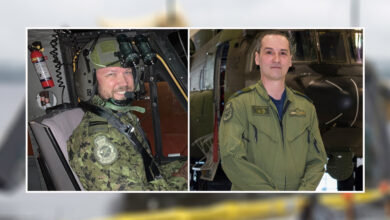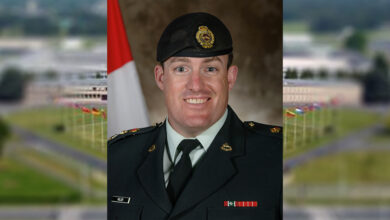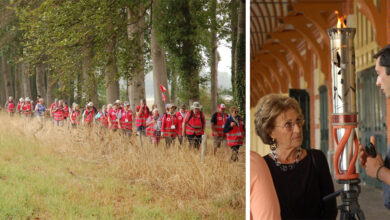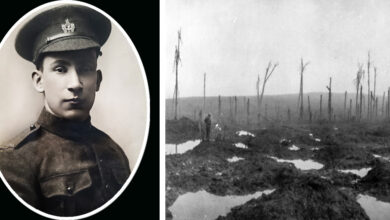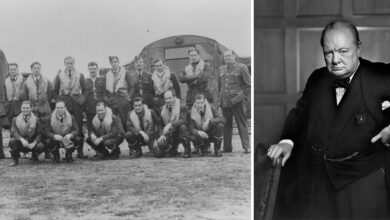Remembering
Three Canadian First World War fallen soldiers identified
The remains of three Canadian First World War soldiers were found near the village of Vendin-le-Vieil, France. The Department of National Defence (DND) and the Canadian Armed Forces (CAF) have identified them as Private William Del Donegan, Private Henry Edmonds Priddle, and Sergeant Archibald Wilson. The soldiers’ remains were recovered between September 2010 and August 2011, in the same area near the village.
When the remains were recovered, the Commonwealth War Graves Commission (CWGC) was notified and with the support of the French authorities, took possession of the remains. They were then transported to a CWGC facility in Beaurains, France, for safekeeping.
The three soldiers were from Manitoba and enlisted in Winnipeg. All three of the soldiers died during the Battle of Hill 70 on August 16, 1917, as members of the 16th Battalion, Canadian Expeditionary Force (CEF), a unit bolstered by The Canadian Scottish Regiment (Princess Mary’s) of Victoria, B.C.
Private William Del Donegan was born on March 27, 1897, in Ottawa. As a child, he and his family moved to Winnipeg. At the age of 18, Private Donegan enlisted in the CEF on February 21, 1916. He joined the 16th Battalion CEF in France on April 21, 1917. He was 20 when he passed away.
Private Henry Edmonds Priddle was born on May 17, 1884, in Norwich, Ont. In 1910, he married Florence Hazen and the couple later settled in Winnipeg. When he was 31, he enlisted in the CEF on April 1, 1916 and joined the 16th Battalion CEF in France on May 9, 1917. He was 33 when he passed away.
Sergeant Archibald Wilson was born on February 12, 1892, in Campsie, Scotland. He was one of 11 children and came to Canada with three brothers and two sisters in June 1910. Sergeant Wilson had dreams of eventually settling and farming in Winnipeg. He enlisted in the CEF on December 18, 1914, at age 22. He joined the 16th Battalion on December 22, 1915 and participated in several battles throughout 1916 and the beginning of 1917. On June 4, 1917, Wilson was promoted to Sergeant, and he died at the age of 25.
The Battle of Hill 70 took place between August 15 to 25, 1917. It was the first major action fought by the Canadian Corps under a Canadian commander during the First World War. Around 2,100 Canadians paid the ultimate price in the battle, over 1,300 of those have no known grave. The strategic high point of Hill 70 stayed with Allied hands until the war ended.
“As Canada marks this year the 100th anniversary of the end of the First World War, we pay tribute to Private Donegan, Private Priddle, and Sergeant Wilson. They are among the nearly 61,000 brave Canadians who gave their lives during the First World War, so that all of us might live in peace and security. While there is no way to sufficiently thank them for their sacrifice, we forever hold them in our memories,” said Defence Minister Harjit S. Sajjan in a press release issued May 22.
The families of the three soldiers have been notified by DND and the CAF, while Veterans Affairs Canada provides them with ongoing support as the final arrangements are made. The three soldiers will be buried by their regiment, with family and the Government of Canada representatives in attendance, at the Commonwealth War Graves Commission’s (CWGC) Loos British Cemetery outside Loos-en-Gohelle, France, on August 23 at 1:30 p.m. (Central European Time). The public has been invited to attend.
“A century has passed since these three soldiers made the ultimate sacrifice on a battlefield half a world away, but time has not diminished their legacy. It seems fitting that their final resting place is in the land which they helped to free. We will lay them to rest with the honour they and their families deserve. May they never be forgotten,” said Veterans Affairs Minister and Associate Minister of National Defence Seamus O’Regan in a press release issued May 22.
The DND’s Casualty Identification Program goal is to identify the remains of unknown soldiers when they are discovered, so they can be buried with a name by their regiment and in the presence of family. In working towards this aim, the program promotes a sense of continuity and identity within the CAF, providing an opportunity for all Canadians to reflect upon the experiences of the men and women who made the ultimate sacrifice for their country.
“We are honoured to have shared in the efforts to bring these lost soldiers to the attention of Canadians, as we will be honoured again later this year to mark their graves with headstones so that all who pass by will know what they gave for us,” said Brigadier-General (Ret.) David Kettle, Secretary General, the Canadian Agency of the CWGC in a press release issued May 22.
The CWGC commemorates the 1.7 million servicemen and women who died during the two world wars. It also holds and updates a vast records archive. The Commission operates in more than 23,000 locations in over 150 countries.



